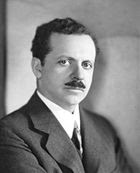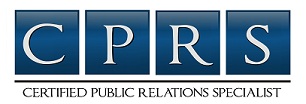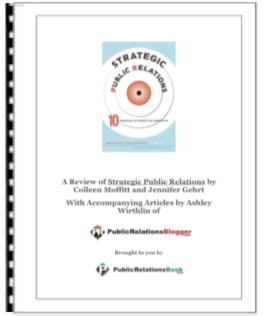________________________________________________________________________
 The history of public relations is mostly confined to the early half of the twentieth century; however there is evidence of the practices scattered through history. One notable practitioner was Georgiana Cavendish, Duchess of Devonshire whose efforts on behalf of Charles James Fox in the 18th century included press relations, lobbying and, with her friends, celebrity campaigning.
The history of public relations is mostly confined to the early half of the twentieth century; however there is evidence of the practices scattered through history. One notable practitioner was Georgiana Cavendish, Duchess of Devonshire whose efforts on behalf of Charles James Fox in the 18th century included press relations, lobbying and, with her friends, celebrity campaigning.
A number of American precursors to public relations are found in the form of publicists who specialized in promoting circuses, theatrical performances, and other public spectacles. In the United States, where public relations has its origins, many early public relations practices were developed in support of railroads. In fact, many scholars believe that the first appearance of the term "public relations" appeared in the 1897 Year Book of Railway Literature [2].
Later, practitioners were — and are still often — recruited from the ranks of journalism. Some reporters concerned with ethics criticize former colleagues for using their inside understanding of news media to help clients receive favorable media coverage.
The first "names"
Some historians regard Ivy Lee as the first real practitioner of public relations, but Edward Bernays, a nephew and student of Sigmund Freud, is generally regarded today as the profession's founder. In the United Kingdom Sir Basil Clarke (1879 - 1947) was a pioneer of public relations.
The First World War helped stimulate the development of public relations as a profession. Many of the first PR professionals, including Ivy Lee, Edward Bernays, John W. Hill, and Carl Byoir, got their start with the Committee on Public Information (also known as the Creel Committee), which organized publicity on behalf of U.S. objectives during World War I.
Edward Bernays was the self-appointed Father of Public Relations.
In describing the origin of the term Public Relations, Bernays commented, "When I came back to the United States [from the war], I decided that if you could use propaganda for war, you could certainly use it for peace. And propaganda got to be a bad word because of the Germans ... using it. So what I did was to try to find some other words, so we found the words Counsel on Public Relations".
Ivy Lee, who has been credited with developing the modern news release (also called a "press release"), espoused a philosophy consistent with what has sometimes been called the "two-way street" approach to public relations in which PR consists of helping clients listen as well as communicate messages to their publics. In the words of the Public Relations Society of America (PRSA), "Public relations helps an organization and its publics adapt mutually to each other." In practice, however, Lee often engaged in one-way propagandizing on behalf of clients despised by the public, including Standard Oil founder John D. Rockefeller. Shortly before his death, the US Congress had been investigating Rockefeller's work on behalf of the controversial Nazi German company IG Farben.
Bernays was the profession's first theorist. Bernays drew many of his ideas from Sigmund Freud's theories about the irrational, unconscious motives that shape human behaviour. Bernays authored several books, including Crystallizing Public Opinion (1923), Propaganda (1928), and The Engineering of Consent (1947). He saw public relations as an "applied social science" that uses insights from psychology, sociology, and other disciplines to scientifically manage and manipulate the thinking and behavior of an irrational and "herdlike" public. "The conscious and intelligent manipulation of the organized habits and opinions of the masses is an important element in democratic society," he wrote in Propaganda, "Those who manipulate this unseen mechanism of society constitute an invisible government which is the true ruling power of our country."
In the 1890s when gender role reversals could be caricaturized, the idea of an aggressive woman who also smoked was considered laughable. In 1929, Edward Bernays proved otherwise when he convinced women to smoke in public during an Easter parade in Manhattan as a show of defiance against male domination. The demonstrators were not aware that a tobacco company was behind the publicity stunt.
One of Bernays' early clients was the tobacco industry. In 1929, he orchestrated a now-legendary publicity stunt aimed at persuading women to take up cigarette smoking, an act that at the time was exclusively equated with men. It was considered unfeminine and inappropriate for women to smoke; besides the occasional prostitute, virtually no women participated in the act publicly. (Indeed, in some countries this is very much still the case.)
Bernays initially consulted psychoanalyst A. A. Brill for advice, Brill told him: "Some women regard cigarettes as symbols of freedom... Smoking is a sublimation of oral eroticism; holding a cigarette in the mouth excites the oral zone. It is perfectly normal for women to want to smoke cigarettes. Further the first women who smoked probably had an excess of male components and adopted the habit as a masculine act. But today the emancipation of women has suppressed many feminine desires. More women now do the same work as men do.... Cigarettes, which are equated with men, become torches of freedom."
Upon hearing this analysis, Bernays dubbed his PR campaign the: "Torches of Liberty Contingent".
It was in this spirit that Bernays arranged for New York City débutantes to march in that year's Easter Day Parade, defiantly smoking cigarettes as a statement of rebellion against the norms of a male-dominated society. Publicity photos of these beautiful fashion models smoking "Torches of Liberty" were sent to various media outlets and appeared worldwide. As a result, the taboo was dissolved and many women were led to associate the act of smoking with female liberation. Some women went so far as to demand membership in all-male smoking clubs, a highly controversial act at the time. For his work, Bernays was paid a tidy sum by George Washington Hill, president of the American Tobacco Company.
Though not a commercial success in Europe, Paul Chabas's September Morn ended up in the permanent collection of the New York Metropolitan Museum of Art after scandalising Anthony Comstock.
Another early practitioner was Harry Reichenbach (1882-1931) a New York-based American press agent and publicist who promoted movies. He claims to have made famous the Paul Chabas painting, September Morn. Supposedly, he saw a print in a Chicago art store window. He made a deal with the store owner who had not sold any of his 2,000 prints. Reichenbach had hired some boys to "ogle" the picture when he showed it to the moralist crusader Anthony Comstock. Comstock was suitably outraged when he saw it. Comstock's Anti-Vice Society took the case to the court and lost. However, the case aroused interest to the painting, which ultimately sold millions of copies.
In 1982 effective Public Relations helped save the Johnson & Johnson Corporation, after the highly publicized Tylenol poisoning crisis.
The History of Public Relations | A Brief Overview
________________________________________
 The history of public relations is mostly confined to the early half of the twentieth century; however there is evidence of the practices scattered through history. One notable practitioner was Georgiana Cavendish, Duchess of Devonshire whose efforts on behalf of Charles James Fox in the 18th century included press relations, lobbying and, with her friends, celebrity campaigning.
The history of public relations is mostly confined to the early half of the twentieth century; however there is evidence of the practices scattered through history. One notable practitioner was Georgiana Cavendish, Duchess of Devonshire whose efforts on behalf of Charles James Fox in the 18th century included press relations, lobbying and, with her friends, celebrity campaigning.A number of American precursors to public relations are found in the form of publicists who specialized in promoting circuses, theatrical performances, and other public spectacles. In the United States, where public relations has its origins, many early public relations practices were developed in support of railroads. In fact, many scholars believe that the first appearance of the term "public relations" appeared in the 1897 Year Book of Railway Literature [2].
Later, practitioners were — and are still often — recruited from the ranks of journalism. Some reporters concerned with ethics criticize former colleagues for using their inside understanding of news media to help clients receive favorable media coverage.
The first "names"
Some historians regard Ivy Lee as the first real practitioner of public relations, but Edward Bernays, a nephew and student of Sigmund Freud, is generally regarded today as the profession's founder. In the United Kingdom Sir Basil Clarke (1879 - 1947) was a pioneer of public relations.
The First World War helped stimulate the development of public relations as a profession. Many of the first PR professionals, including Ivy Lee, Edward Bernays, John W. Hill, and Carl Byoir, got their start with the Committee on Public Information (also known as the Creel Committee), which organized publicity on behalf of U.S. objectives during World War I.
Edward Bernays was the self-appointed Father of Public Relations.
In describing the origin of the term Public Relations, Bernays commented, "When I came back to the United States [from the war], I decided that if you could use propaganda for war, you could certainly use it for peace. And propaganda got to be a bad word because of the Germans ... using it. So what I did was to try to find some other words, so we found the words Counsel on Public Relations".
Ivy Lee, who has been credited with developing the modern news release (also called a "press release"), espoused a philosophy consistent with what has sometimes been called the "two-way street" approach to public relations in which PR consists of helping clients listen as well as communicate messages to their publics. In the words of the Public Relations Society of America (PRSA), "Public relations helps an organization and its publics adapt mutually to each other." In practice, however, Lee often engaged in one-way propagandizing on behalf of clients despised by the public, including Standard Oil founder John D. Rockefeller. Shortly before his death, the US Congress had been investigating Rockefeller's work on behalf of the controversial Nazi German company IG Farben.
Bernays was the profession's first theorist. Bernays drew many of his ideas from Sigmund Freud's theories about the irrational, unconscious motives that shape human behaviour. Bernays authored several books, including Crystallizing Public Opinion (1923), Propaganda (1928), and The Engineering of Consent (1947). He saw public relations as an "applied social science" that uses insights from psychology, sociology, and other disciplines to scientifically manage and manipulate the thinking and behavior of an irrational and "herdlike" public. "The conscious and intelligent manipulation of the organized habits and opinions of the masses is an important element in democratic society," he wrote in Propaganda, "Those who manipulate this unseen mechanism of society constitute an invisible government which is the true ruling power of our country."
In the 1890s when gender role reversals could be caricaturized, the idea of an aggressive woman who also smoked was considered laughable. In 1929, Edward Bernays proved otherwise when he convinced women to smoke in public during an Easter parade in Manhattan as a show of defiance against male domination. The demonstrators were not aware that a tobacco company was behind the publicity stunt.
One of Bernays' early clients was the tobacco industry. In 1929, he orchestrated a now-legendary publicity stunt aimed at persuading women to take up cigarette smoking, an act that at the time was exclusively equated with men. It was considered unfeminine and inappropriate for women to smoke; besides the occasional prostitute, virtually no women participated in the act publicly. (Indeed, in some countries this is very much still the case.)
Bernays initially consulted psychoanalyst A. A. Brill for advice, Brill told him: "Some women regard cigarettes as symbols of freedom... Smoking is a sublimation of oral eroticism; holding a cigarette in the mouth excites the oral zone. It is perfectly normal for women to want to smoke cigarettes. Further the first women who smoked probably had an excess of male components and adopted the habit as a masculine act. But today the emancipation of women has suppressed many feminine desires. More women now do the same work as men do.... Cigarettes, which are equated with men, become torches of freedom."
Upon hearing this analysis, Bernays dubbed his PR campaign the: "Torches of Liberty Contingent".
It was in this spirit that Bernays arranged for New York City débutantes to march in that year's Easter Day Parade, defiantly smoking cigarettes as a statement of rebellion against the norms of a male-dominated society. Publicity photos of these beautiful fashion models smoking "Torches of Liberty" were sent to various media outlets and appeared worldwide. As a result, the taboo was dissolved and many women were led to associate the act of smoking with female liberation. Some women went so far as to demand membership in all-male smoking clubs, a highly controversial act at the time. For his work, Bernays was paid a tidy sum by George Washington Hill, president of the American Tobacco Company.
Though not a commercial success in Europe, Paul Chabas's September Morn ended up in the permanent collection of the New York Metropolitan Museum of Art after scandalising Anthony Comstock.
Another early practitioner was Harry Reichenbach (1882-1931) a New York-based American press agent and publicist who promoted movies. He claims to have made famous the Paul Chabas painting, September Morn. Supposedly, he saw a print in a Chicago art store window. He made a deal with the store owner who had not sold any of his 2,000 prints. Reichenbach had hired some boys to "ogle" the picture when he showed it to the moralist crusader Anthony Comstock. Comstock was suitably outraged when he saw it. Comstock's Anti-Vice Society took the case to the court and lost. However, the case aroused interest to the painting, which ultimately sold millions of copies.
Standards
In 1950 PRSA enacts the first "Professional Standards for the Practice of Public Relations," a forerunner to the current Code of Ethics, last revised in 2000 to include six core values and six code provisions. The six core values are "Advocacy, Honesty, Expertise, Independence, Loyalty, and Fairness." The six code provisions consulted with are "Free Flow of Information, Competition, Disclosure of Information, Safeguarding Confidences, Conflicts of Interest, and Enhancing the Profession."
In 1950 PRSA enacts the first "Professional Standards for the Practice of Public Relations," a forerunner to the current Code of Ethics, last revised in 2000 to include six core values and six code provisions. The six core values are "Advocacy, Honesty, Expertise, Independence, Loyalty, and Fairness." The six code provisions consulted with are "Free Flow of Information, Competition, Disclosure of Information, Safeguarding Confidences, Conflicts of Interest, and Enhancing the Profession."
In 1982 effective Public Relations helped save the Johnson & Johnson Corporation, after the highly publicized Tylenol poisoning crisis.
Article Source.
Subscribe to:
Post Comments (Atom)






Comments (0)
Post a Comment